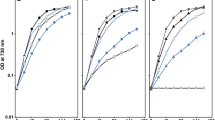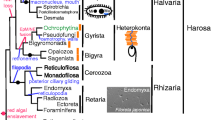Abstract
The involvement of type I chaperonins in bacterial and organellar protein folding has been well-documented. In E. coli and mitochondria, these ubiquitous and highly conserved proteins form chaperonin oligomers of identical 60 kDa subunits (cpn60), while in chloroplasts, two distinct cpn60 α and β subunit types co-exist together. The primary sequence of α and β subunits is ~50% identical, similar to their respective homologies to the bacterial GroEL. Moreover, the A. thaliana genome contains two α and four β genes. The functional significance of this variability in plant chaperonin proteins has not yet been elucidated. In order to gain insight into the functional variety of the chloroplast chaperonin family members, we reconstituted β homo-oligomers from A. thaliana following their expression in bacteria and subjected them to a structure–function analysis. Our results show for the first time, that A. thaliana β homo-oligomers can function in vitro with authentic chloroplast co-chaperonins (ch-cpn10 and ch-cpn20). We also show that oligomers made up of different β subunit types have unique properties and different preferences for co-chaperonin partners. We propose that chloroplasts may contain active β homo-oligomers in addition to hetero-oligomers, possibly reflecting a variety of cellular roles.







Similar content being viewed by others
Abbreviations
- MDH:
-
Malate dehydrogenase
- TEV:
-
Tobacco Etch virus
- Mt:
-
Mitochondrial
- Ch:
-
Chloroplast
- cpn10:
-
10 kDa co-chaperonin
- cpn60:
-
60 kDa chaperonin
- β homo-oligomer:
-
ch-cpn60 oligomer composed of identical β subunits
- αβ hetero-oligomer:
-
ch-cpn60 oligomer composed of a mixture of α and β subunits
- CD:
-
Circular dichroism
- DTT:
-
Dithiothreitol
References
Apuya NR et al (2001) The Arabidopsis embryo mutant schlepperless has a defect in the chaperonin-60α gene. Plant Physiol 126(2):717–730
Bonk M et al (1996) Purification and characterization of chaperonin 60 and heat-shock protein 70 from chromoplasts of Narcissus pseudonarcissus. Plant Physiol 111(3):931–939
Bonshtien AL et al (2007) Significance of the N-terminal domain for the function of chloroplast cpn20 chaperonin. J Biol Chem 282(7):4463–4469
Bonshtien AL et al (2009) Differential effects of co-chaperonin homologs on cpn60 oligomers. Cell Stress Chaperones 14(5):509–519
Cloney LP, Wu HB, Hemmingsen SM (1992) Expression of plant chaperonin-60 genes in c coli. J Biol Chem 267(32):23327–23332
Dickson R et al (2000) Reconstitution of higher plant chloroplast chaperonin 60 tetradecamers active in protein folding. J Biol Chem 275(16):11829–11835
Fenton WA et al (1994) Residues in chaperonin GroEL required for polypeptide binding and release. Nature 371(6498):614–619
Georgopoulos C (2006) Toothpicks, serendipity and the emergence of the Escherichia coli DnaK (Hsp70) and GroEL (Hsp60) chaperone machines. Genetics 174(4):1699–1707
Gur E et al (2002) In vivo aggregation of a single enzyme limits growth of Escherichia coli at elevated temperatures. Mol Microbiol 46(5):1391–1397
Hartl FU (1996) Molecular chaperones in cellular protein folding. Nature 381(6583):571–579
Hemmingsen SM, Ellis RJ (1986) Purification and properties of ribulosebisphosphate carboxylase large subunit binding protein. Plant Physiol 80(1):269–276
Hemmingsen SM et al (1988) Homologous plant and bacterial proteins chaperone oligomeric protein assembly. Nature 333(6171):330–334
Hill JE, Hemmingsen SM (2001) Arabidopsis thaliana type I and II chaperonins. Cell Stress Chaperones 6(3):190–200
Horwich AL et al (2007) Two families of chaperonin: physiology and mechanism. Annu Rev Cell Dev Biol 23:115–145
Ishikawa A et al (2003) Deletion of a chaperonin 60β gene leads to cell death in the Arabidopsis lesion initiation 1 mutant. Plant Cell Physiol 44(3):255–261
Koike-Takeshita A et al (2006) Leu309 plays a critical role in the encapsulation of substrate protein into the internal cavity of GroEL. J Biol Chem 281(2):962–967
Lund PA (2009) Multiple chaperonins in bacteria–why so many? FEMS Microbiol Rev 33(4):785–800
Martel R et al (1990) Unique composition of plastid chaperonin-60: alpha and beta polypeptide-encoding genes are highly divergent. Gene 94(2):181–187
Musgrove JE, Johnson RA, Ellis RJ (1987) Dissociation of the ribulosebisphosphate-carboxylase large-subunit binding protein into dissimilar subunits. Euro J Biochem 163(3):529–534
Nishio K, Hirohashi T, Nakai M (1999) Chloroplast chaperonins: evidence for heterogeneous assembly of alpha and beta Cpn60 polypeptides into a chaperonin oligomer. Biochem Biophys Res Commun 266(2):584–587
Opatowsky Y et al (2003) The voltage-dependent calcium channel beta subunit contains two stable interacting domains. J Biol Chem 278(52):52323–52332
Peltier JB et al (2006) The oligomeric stromal proteome of Arabidopsis thaliana chloroplasts. Mol Cell Proteomics 5(1):114–133
Qamra R, Srinivas V, Mande SC (2004) Mycobacterium tuberculosis GroEL homologues unusually exist as lower oligomers and retain the ability to suppress aggregation of substrate proteins. J Mol Biol 342(2):605–617
Salvucci ME (2008) Association of Rubisco activase with chaperonin-60β: a possible mechanism for protecting photosynthesis during heat stress. J Exp Bot 59(7):1923–1933
Sharkia R et al (2003) On the oligomeric state of chloroplast chaperonin 10 and chaperonin 20. Biochim Biophys Acta 1651(1–2):76–84
Sigler PB et al (1998) Structure and function in GroEL-mediated protein folding. Annu Rev Biochem 67:581–608
Suzuki K et al (2009) Plastid chaperonin proteins cpn60α and cpn60β are required for plastid division in Arabidopsis thaliana. BMC Plant Biol 9:38
Viitanen PV et al (1995) Functional characterization of the higher plant chloroplast chaperonins. J Biol Chem 270(30):18158–18164
Viitanen PV et al (1998) Purification of recombinant plant and animal GroES homologs: chloroplast and mitochondrial chaperonin 10. Methods Enzymol 290:218–230
Weiss C et al (2009) Cpn20: siamese twins of the chaperonin world. Plant Mol Biol 69(3):227–238
Xu Z, Sigler PB (1998) GroEL/GroES: structure and function of a two-stroke folding machine. J Struct Biol 124(2–3):129–141
Acknowledgments
This work was supported by the Binational Agricultural Research and Development Fund (BARD Project IS-3906-06). We would like to thank Avital Parnas for useful discussions and critical review of this manuscript.
Author information
Authors and Affiliations
Corresponding author
Electronic supplementary material
Below is the link to the electronic supplementary material
Rights and permissions
About this article
Cite this article
Vitlin, A., Weiss, C., Demishtein-Zohary, K. et al. Chloroplast β chaperonins from A. thaliana function with endogenous cpn10 homologs in vitro. Plant Mol Biol 77, 105–115 (2011). https://doi.org/10.1007/s11103-011-9797-6
Received:
Accepted:
Published:
Issue Date:
DOI: https://doi.org/10.1007/s11103-011-9797-6




